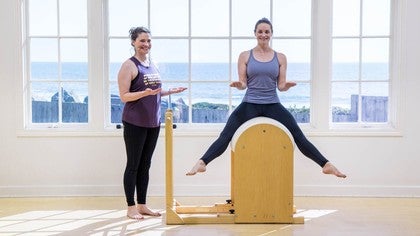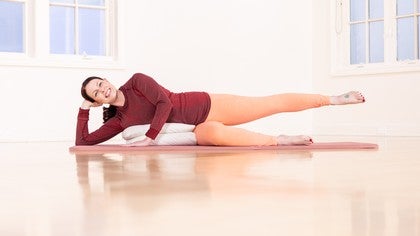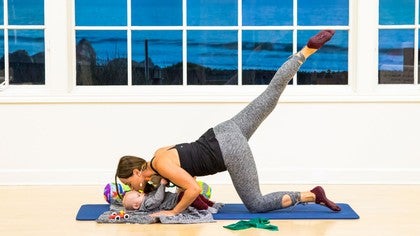
Pilates for Pelvic Health: Everything You Need to Know
According to Madeline Black, a Sonoma, California-based Pilates instructor who created the new Pelvic Health program for Pilates Anytime, pelvic health issues should not be accepted as normal or as part of the aging process "Whether a person is 12 or 80, everyone should learn about pelvic health," says Black. This blog piece is an introduction to Black's work in this area. Read on to discover simple tools and strategies for maintaining pelvic health.
Black uses the term "pelvic health" to encompass all parts of the body below the navel and above the legs, an area also called the lumbo-pelvic-hip complex. Common neuro-myofascial skeletal pelvic issues include sacroiliac joint pain, sciatica, anterior hip syndrome, piriformis syndrome, and lateral hip pain. Pelvic issues can also result from the digestive, reproductive, or urinary systems.
“A combination of lumbo-pelvic-hip resetting movements, strengthening exercises, and movement control helps improve pelvic function and decrease pain,” Black says. The pelvic diaphragm may be hypotonic, or weak from laxity, or hypertonic, which means weak from tightness. In both men and women, stress and lifestyle factors can aggravate pelvic diaphragm spasm and pain. People with a history of pelvic radiation or pelvic surgery are at higher risk for pelvic disorders. According to Black, health disparities for those who experience systemic disadvantage due to race, ethnicity, nationality, religion, socio-economic status, gender, gender identity, sexual orientation, age, size, or ability can also lead to higher incidences of pelvic health issues.
Help for Pelvic Issues
How can we improve our pelvic health, or improve existing pelvic issues? “Just as people exercise and eat well to help prevent heart disease, obesity and diabetes, they can also work to improve their pelvic health throughout their lives,” says Black. She recommends meditation, guided relaxation, and warm baths to relax overly tight pelvic muscles, avoiding constipation by consuming ample fluids and fiber, and exercising regularly. Conversely, if the pelvic and diaphragm muscles are too lax, Black suggests practicing light bearing down, as in coughing, maintaining a healthy weight, and avoiding heavy lifting which can lead to organ prolapse.
Below, you’ll find some simple exercises drawn from Black’s recent pelvic health series on Pilates Anytime. Incorporating these practices into your daily routine, in conjunction with cultivating postural awareness, will help bring your pelvis into balance.
“Improving ease of motion, hip joint mobility, and thoracic mobility, cultivating relaxation, and opening up the sit bones will help get your pelvic diaphragm in a great place to be for the rest of your day,” says Black.
Six Exercises for Pelvic Health
If you have experienced pelvic health issues, consult a physician before incorporating these or any exercises.
Standing
“Awareness of how you sit and you stand is important to the pelvic health, because people who like to stand in a hip sway for long periods of time create an imbalance in the trunk,” says Black, “Optimally, we want to feel our weight equal on both legs.” If you tend to lean into one hip when you are tired, Black suggests making a mental note to bring yourself into balance, or go ahead and lean into the other hip for a chance to even things out. In your daily life and activities, try to become more aware of how you're standing and correct yourself if you consistently favor one side.
Sitting
We spend so much time sitting these days that it’s important to sit well. Sitting with your legs dangling creates a pull on the pelvis, encouraging it to fall a little bit forward. If your feet don’t reach the floor when you’re sitting, invest in a footrest or upgrade to an adjustable desk chair that will allow your feet to be in contact with something.
The bones at the bottom of the pelvis are called ischial tuberosities, or sit bones. “You want to feel that you're equally weighted on both of those sit bones,” says Black. “You can think of those sit bones as your feet. Just as you would if you lean into one hip while standing, if you sit on one side more than the other, you’ll create an imbalance.”
Similarly, sitting with your legs crossed, which many of us do, will create an imbalance in the hips over time. “If you find yourself always crossing your right leg over your left leg, try to sit with your left leg over the right so that you're at least getting a little bit more balance between your right and left side,” Black suggests.
Twisting
Doing some easy spinal twists while you're sitting is good for the pelvic floor. Inhale to create space and lengthen the spine, then twist on the exhale. “You can actually hold the twist and breathe into the opposite side, opening those ribs a little bit, and then exhale and return to center,” suggests Black. Why not program a reminder in your phone to take a twisting break two or three times throughout the day as you're sitting?
Side Lying
Lie on your side with your bottom arm extended out above the head, resting your head on your upper arm, and bring your knees and feet together with the knees bent and the heels lined up with the tailbone. Squeeze the heels together as you just lift the top knee a few inches (external rotation). Lift and lower the top knee a few times. It’s a gentle motion. “You’re just trying to get some mobility in the hips,” says Black. Repeat on the other side.Prone
Lie facedown on your stomach with elbows bent and your hands folded beneath your forehead. Open your legs wider than your hips to create a feeling of width in the sit bones. Inhale to begin, and as you exhale, imagine your sacrum (the bony structure at the base of the spine) sinking into the mat. On the inhale, feel the sacrum float in space. As you exhale, once again feel the sacrum descending towards the mat.
Quadruped
This simple variation on “Thread the Needle” lubricates and mobilizes the thorax, or chest region. From a quadruped or all-fours position, lift one arm up and out to the side at shoulder height. Follow your hand with your gaze. Then lower that arm and slide it beneath you, palm facing up, turning the head and looking over your opposite shoulder. Repeat several times on both sides.
Let us know how these practices work for you in the comments below.
Comments
No comments yet. Be the first!













You need to be a subscriber to post a comment.
Please Log In or Create an Account to start your free trial.